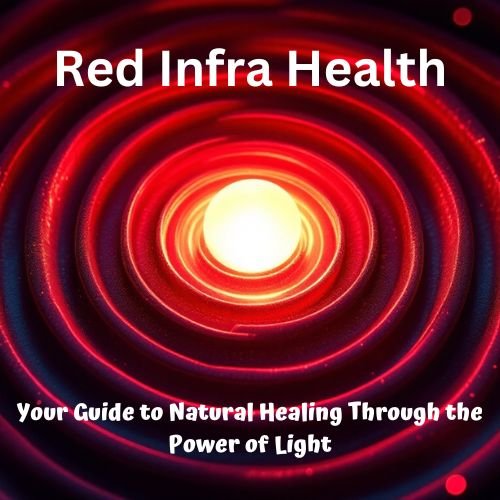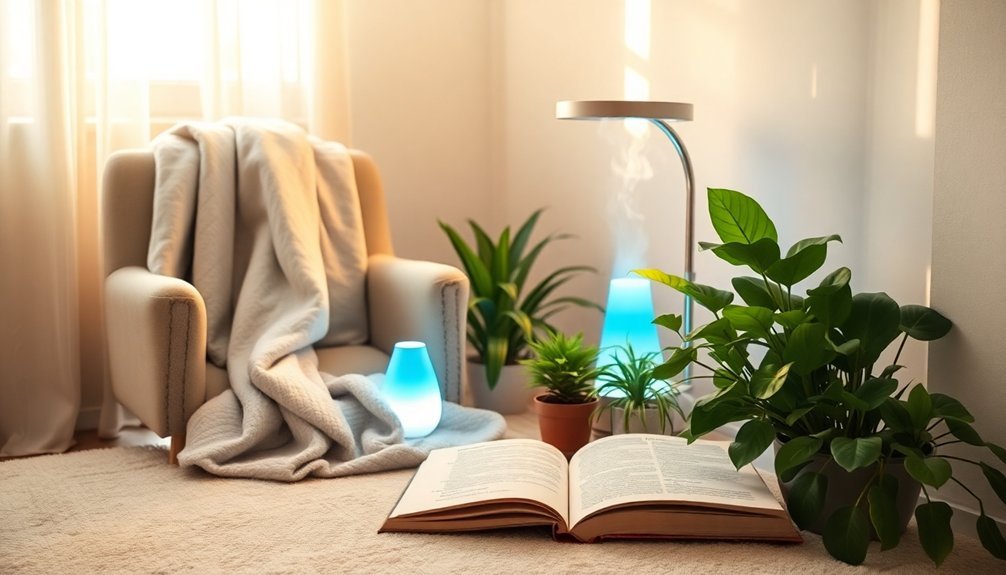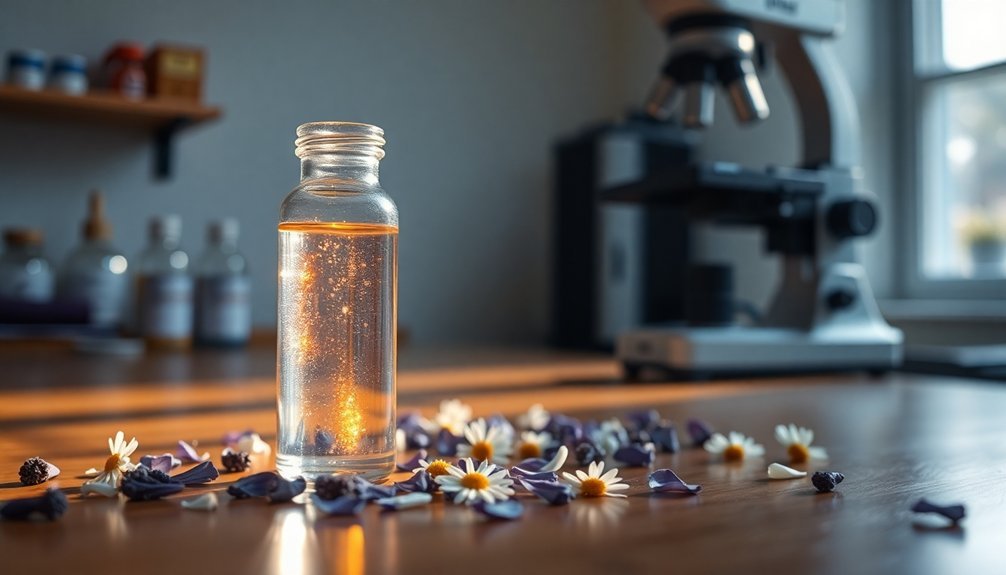Several natural therapies can effectively soothe your eye inflammation at home. You can apply warm or cold compresses to reduce swelling and stimulate healing blood flow. Cucumber slices and green tea bags work well as cooling agents, while rose water helps relieve irritation. Natural anti-inflammatories like honey and castor oil can treat various eye conditions when used properly. Traditional Ayurvedic treatments such as Netra Tarpana (medicated ghee bath) offer time-tested relief. You'll also find comfort in simple salt water solutions and herbal remedies like eyebright and chamomile. Discovering the right combination of these gentle treatments could be your key to lasting eye comfort.
Understanding Eye Inflammation

Nearly every person will experience eye inflammation at some point in their life. When inflammation occurs, it can affect different parts of your eye, from the front surface to deep internal structures. Understanding what's happening in your eye is essential for proper treatment and relief.
You'll typically notice several telltale signs when your eyes become inflamed. These include redness, swelling, and itching, which may be accompanied by blurred vision, eye pain, or the appearance of floaters in your field of vision. People with anterior uveitis often experience severe light sensitivity.
The inflammation can stem from various sources, including infections, injuries, medications, or underlying health conditions like rheumatoid arthritis and lupus.
Your eye's anatomy plays a key role in how inflammation manifests. The front of your eye, including the conjunctiva and sclera, can develop conditions like episcleritis or scleritis.
The middle layer, known as the uvea, may experience uveitis or vitritis. Inflammation can also affect your retina at the back of the eye or impact your optic nerve.
To properly diagnose the cause, your doctor may perform a dilated eye exam or order blood tests, which will help determine the most effective treatment approach.
Red Light Benefits For Eyes
Red light therapy offers powerful healing properties for your eyes by reducing inflammation and protecting retinal cells through enhanced mitochondrial function.
You'll find this treatment particularly effective for conditions like dry eye syndrome and age-related macular degeneration, as it stimulates tear production and promotes cellular repair. Research shows ATP energy production significantly increases in ocular cells when exposed to red light wavelengths.
When using red light therapy for your eyes, it's crucial to follow proper guidelines, including maintaining the recommended 20-minute session duration and using only clinically tested devices designed specifically for ocular treatment.
Healing Properties Explained
Modern science has revealed powerful healing properties in red light therapy for treating eye conditions. When you're dealing with eye inflammation, red light therapy can substantially reduce swelling while preserving your eyes' ATP energy production.
It's particularly effective at accelerating the healing of corneal injuries and providing relief from dry eye syndrome. Using red light therapy for just three minutes weekly can improve your visual acuity by up to 20%.
Red light therapy works at the cellular level by boosting ATP production in your ocular cells. This enhanced cellular energy improves your retinal function and increases early cell survival rates by 20%. The therapy stimulates your mitochondria, making your eye cells more energy-efficient and protecting them from further damage.
For specific conditions, you're looking at impressive benefits. If you have glaucoma, red light therapy helps protect your cornea and retina from pressure damage.
It's also showing promise for age-related macular degeneration by increasing ATP production. The therapy accelerates healing after eye surgeries and helps with corneal burns through enhanced collagen synthesis and improved blood flow.
You'll also notice better tear production, which addresses the root cause of dry eye syndrome.
Safe Usage Guidelines
Following four essential guidelines will help you safely benefit from red light therapy for your eyes.
First, always wear specialized protective goggles or masks during treatment to prevent direct exposure to the light source. You'll need to position the device 6 to 12 inches from your eyes, following professional recommendations.
Second, start with brief 5 to 10-minute sessions, gradually increasing duration as your eyes adjust to the treatment.
Third, don't attempt self-treatment without consulting an eye specialist, particularly if you have chronic conditions. You'll achieve better results under professional guidance, as they'll guarantee proper administration and monitoring of your progress.
Fourth, maintain consistency with multiple weekly sessions while using only devices specifically designed for eye treatments. The therapy enhances cellular ATP production to promote natural healing processes.
Remember that while red light therapy is non-invasive and generally side-effect-free, you should never stare directly into the light source. The therapy uses low-intensity light in the mid-600nm (red) and mid-800nm (near-infrared) ranges, which won't generate harmful heat.
When properly administered, this treatment can effectively reduce inflammation, improve vision, and accelerate healing in various eye conditions.
Natural Light Healing Methods

Natural sunlight can boost your eye health by promoting tear production and helping regulate your circadian rhythm.
You'll benefit from spending 10-15 minutes daily in early morning sunlight, which helps your eyes adjust naturally to light exposure while avoiding harsh midday rays.
Inside your home, you can position your workspace near windows or use full-spectrum lights that mimic natural daylight to support healthy eye function throughout the day.
Sunlight Benefits For Eyes
Sunlight plays a vital role in maintaining and improving eye health through several proven mechanisms. When you expose your eyes to natural light, particularly during childhood, you're helping prevent myopia development. The visible light stimulates dopamine release in your retina, which inhibits axial elongation – a primary cause of nearsightedness.
You'll also benefit from sunlight's natural anti-inflammatory properties, especially from its long wavelengths (600-1000 nm). These wavelengths increase ATP levels in your eye tissues and enhance mitochondrial function, potentially helping conditions like age-related macular degeneration.
The anti-inflammatory effects can protect both your ocular lens and macula from damage.
Conscious sun exposure helps maintain ideal vitamin D levels, which is vital for preventing various eye conditions like dry eyes and uveitis. You can practice controlled sunning techniques, where indirect light through closed eyelids stimulates your photoreceptor cells. This method can strengthen your visual system and train your eyes' involuntary muscles to respond better to different light levels.
Remember to follow proper safety guidelines and avoid direct sun exposure to prevent damage to your retina.
Natural Lighting Therapy Indoors
While outdoor sunlight offers numerous benefits, you can harness similar healing effects indoors through controlled light therapy methods. Low light therapy provides a gentle, non-invasive approach that's particularly effective for treating eye inflammation and related conditions.
You'll find that low light therapy works at the cellular level, enhancing repair processes and improving circulation around your eyes. It's especially beneficial if you're dealing with styes or ocular rosacea, as it helps reduce swelling and discomfort while promoting natural healing.
Unlike high-intensity treatments, low light therapy won't risk damaging your eyes or creating harmful reactive oxygen species.
If you're considering IPL therapy, you'll need proper eye protection due to its higher intensity. While it's effective at targeting bacteria and improving meibomian gland function, it's more invasive than low light alternatives. For sensitive eyes, you'll likely prefer low light therapy's gentler approach.
You can complement these treatments with simple home remedies. Try applying warm compresses to increase blood flow or cold compresses to reduce swelling.
Salt-based solutions, including Epsom salt baths or saline rinses, can also help soothe inflammation when used alongside light therapy.
Home Remedies and Traditional Cures
Home remedies have stood the test of time in treating eye inflammation, offering relief through simple yet effective methods you can try at home.
You'll find both warm and cold treatments particularly effective, with warm compresses helping to stimulate oil production and cold ones reducing swelling and pain.
For warm therapy, you can create an Epsom salt solution with warm water and apply it using a clean cloth, or make a rice compress by heating uncooked rice in a sock.
If you're dealing with swelling, try placing cucumber slices or a cold washcloth over your closed eyes for 5-10 minutes at a time.
Natural ingredients like aloe vera, honey, and turmeric offer anti-inflammatory benefits. You can mix aloe vera gel with cold water and apply it using cotton rounds, while castor oil drops can help reduce irritation when used before bedtime.
Don't forget about basic hygiene – use saline solution to clean your eyelids gently, and consider a mild massage after warm compresses to help distribute natural oils.
When using any compress, whether warm or cold, always guarantee it's clean and maintain proper hand hygiene.
Ayurvedic Solutions For Eye Health

Traditional Ayurvedic medicine offers a thorough approach to treating eye inflammation through time-tested therapies and natural remedies.
You'll find immediate relief through Netra Tarpana, where medicated ghee bathes your eyes, reducing inflammation and dryness while improving vision clarity.
Tharpanam treatment, using black gram dough rings to hold medicated oils, provides targeted therapy for various eye conditions.
For an extensive treatment plan, you can combine these therapies with Nasya, which clears your nasal passages and reduces eye strain.
Apply Anjana, an herbal eye salve, to soothe irritated eyes and promote healing.
Don't overlook the power of Padabhyanga (foot massage) in your treatment routine, as it reduces overall body stress that can contribute to eye inflammation.
You can enhance these treatments by incorporating simple lifestyle adjustments. Use rose water compresses to calm inflamed eyes, and apply triphala water for additional soothing benefits.
Remember to protect your eyes from excessive sun exposure and avoid overworking them.
For lasting results, consider including amla fruit in your diet, as it helps regulate pitta and supports overall eye health.
Herbal Treatments For Eye Relief
Herbal solutions for eye inflammation offer up some of nature's most potent remedies. You'll find several well-known herbs like eyebright, fennel, and chamomile that can effectively reduce inflammation and soothe irritated eyes. These can be used in teas, tinctures, or homeopathic eye drops under proper guidance.
For thorough eye health, you can turn to powerful extracts like gou qi zi (wolfberries) and bilberry, which help prevent macular degeneration and improve night vision.
Grape seed extract works as a natural antihistamine, while ju hua (chrysanthemum flower) can address issues like blurred and spotty vision.
You'll want to complement these herbal treatments with natural care methods. Try applying warm compresses to soothe irritation, or use artificial tears made from chamomile tea for lubrication.
Green tea and turmeric can provide additional protection through their antioxidant and anti-inflammatory properties.
Remember to exercise caution when using any eye remedies. Don't apply herbs directly into your eyes, and always consult a healthcare professional before starting any treatment.
Maintain good hygiene practices and stay well-hydrated to maximize the benefits of these natural solutions.
Dietary Support For Eye Health

You'll want to focus on essential nutrients like vitamins A, C, and E, along with minerals such as zinc and selenium, which work together to combat eye inflammation and maintain healthy vision.
Omega-3 fatty acids from fish oil play a vital role in supporting retinal function and preventing dry eyes, making fatty fish like salmon and sardines excellent choices for your diet.
For ideal eye health, incorporate dark leafy greens rich in lutein and zeaxanthin, such as kale and spinach, which protect your retina from harmful light exposure.
Essential Eye-Supporting Nutrients
Maintaining excellent eye health depends on getting the right balance of essential nutrients through your diet. Your eyes need specific vitamins, minerals, and compounds that work together to protect against inflammation and maintain ideal function.
| Nutrient Category | Key Components | Best Food Sources |
|---|---|---|
| Vitamins | A, C, E | Citrus fruits, carrots, sweet potatoes, almonds, olive oil |
| Minerals | Zinc, Selenium | Oysters, legumes, eggs, dairy, seafood |
| Essential Fats | Omega-3, DHA | Salmon, tuna, flaxseed, walnuts, chia seeds |
| Carotenoids | Lutein, Zeaxanthin | Dark leafy greens, egg yolks, corn, orange fruits |
You'll find powerful antioxidants in colorful fruits and vegetables that help neutralize harmful free radicals and protect your retinal health. Vitamin C, found in citrus fruits and bell peppers, works alongside vitamin E from nuts and oils to reduce oxidative stress. For superior eye protection, include cold-water fish in your diet for omega-3 fatty acids, which support retinal function and have anti-inflammatory properties. Dark green leafy vegetables are particularly valuable, as they're rich in lutein and zeaxanthin, which help shield your macula from harmful blue and ultraviolet light.
Fish Oil Benefits Eyes
Among the most powerful dietary allies for eye health, fish oil stands out for its remarkable omega-3 fatty acids, EPA and DHA. You'll find these essential nutrients play a vital role in maintaining healthy vision and preventing various eye conditions, including macular degeneration and glaucoma.
If you're dealing with dry eyes, fish oil can help by reducing inflammation and boosting tear production. It's particularly effective at maintaining proper drainage of intraocular fluid, which helps prevent high eye pressure.
For parents, it's worth noting that omega-3s are essential for vision development in children.
You can get your omega-3s through diet or supplements. Rich dietary sources include salmon, tuna, flaxseed oil, walnuts, and soybeans. However, since maintaining adequate omega-3 intake through diet alone can be challenging, you might want to think about fish oil supplements. Just be sure to consult your healthcare provider before starting any supplement regimen.
The key is maintaining a healthy balance between omega-6 and omega-3 fatty acids. When you increase your omega-3 intake, you're not just supporting your eye health – you're investing in a thorough approach to preventing and treating various eye conditions.
Light Therapy Treatment Duration
Light therapy's treatment duration follows a structured schedule that varies by type. If you're considering Low-Level Light Therapy (LLLT), you'll need 2-4 sessions spaced 48 hours apart, with each session lasting 15 minutes.
For Intense Pulsed Light (IPL) therapy, treatments are scheduled 2-4 weeks apart, and you'll typically need four sessions before seeing significant improvements.
During your treatment journey, you can expect:
- A warm sensation during IPL sessions, sometimes described as a gentle rubber band snap against your skin
- Quick 15-minute LLLT sessions that fit easily into your schedule
- Visible improvements in dry eye symptoms often appearing after your third IPL treatment
- The possibility of needing follow-up sessions 6-12 months after your initial series
Your doctor will monitor your progress and adjust the treatment schedule based on your response. While you might experience mild discomfort, redness, or swelling after treatments, these side effects typically resolve within days.
For chronic dry eye management, regular evaluations help determine if you need maintenance treatments to sustain the benefits of your light therapy sessions.
Prevention Through Natural Methods
Beyond medical treatments, natural preventive measures can substantially reduce your risk of eye inflammation. You'll find significant protection through dietary adjustments by incorporating omega-3 rich foods like fish and flax seeds, along with bilberries and ginkgo biloba.
Don't forget to maintain adequate levels of vitamins A, B12, and D through a balanced diet.
Protect your eyes from environmental factors by wearing wraparound sunglasses in harsh conditions and using humidifiers to maintain the best possible air moisture. You'll want to stay well-hydrated and limit your exposure to digital screens, using blue light filters when necessary.
You can implement several home remedies to soothe irritated eyes. Apply warm compresses using hot water or rice-filled socks for comfort, or switch to cold compresses to reduce swelling.
Natural solutions like cucumber slices, rose water, and salt water can provide relief and healing properties.
For daily care, clean your eyelids regularly with diluted baby shampoo or saline solution. Don't rub your eyes when they're irritated, and consider using natural artificial tears. Regular eye exercises can help maintain eye flexibility and reduce strain.
Safety Measures During Treatment
Safety stands paramount when treating eye inflammation through natural methods. You'll need to maintain strict hygiene standards and follow proper application techniques to prevent complications.
Before starting any natural treatment, consult your eye care professional to confirm it's appropriate for your condition, especially if you have existing eye conditions or recent surgery.
Watch for warning signs that require immediate medical attention, including:
- Severe pain accompanied by fever or headache
- Sudden changes in vision or unusual light sensitivity
- Foreign objects or chemical exposure in the eye
- Signs of infection like pus or increased swelling
When applying natural remedies, always use sterile tools and clean hands. If you're using warm compresses, confirm they're made with clean washcloths and appropriate temperature water.
For saline rinses, use only sterilized water and precise salt measurements. Don't apply undiluted substances directly to your eyes, and avoid self-medicating with over-the-counter eye drops.
Keep yourself hydrated and minimize exposure to irritants like chlorinated water and cigarette smoke.
Regular check-ups with your eye care professional are essential to monitor your progress and adjust treatments as needed.
Long Term Eye Care Strategies

Maintaining exceptional eye health requires a thorough, long-term approach that extends far beyond treating occasional inflammations. You'll need to focus on both nutrition and preventive care to protect your vision for years to come.
Start by incorporating eye-friendly foods into your daily diet. Load up on dark leafy greens like kale and spinach, and don't forget to include blue and red berries for their powerful antioxidant properties.
You'll also want to eat fish rich in omega-3 fatty acids, such as salmon and tuna, which help protect your eyes from cellular damage.
Make detailed eye exams a regular part of your healthcare routine, and always wear polarized sunglasses when you're outdoors.
If you smoke, quitting will substantially reduce your risk of developing serious eye conditions like macular degeneration. You'll also want to keep your overall health in check, as conditions like diabetes and high blood pressure can affect your vision.
Stay active to maintain your eye health – regular physical activity helps manage conditions that could impact your vision.
Remember to practice good eye hygiene by washing your hands regularly and keeping your pillowcases clean to prevent infections.
Frequently Asked Questions
Can I Combine Different Natural Remedies Simultaneously for Faster Relief?
You shouldn't combine natural remedies simultaneously as this can cause adverse reactions. Instead, use them sequentially throughout the day, with proper breaks between applications, and always consult your healthcare provider first.
How Soon Should I Seek Medical Attention if Natural Treatments Aren't Working?
If your eye symptoms don't improve after 2-3 days of natural treatments, you should see a doctor. Seek immediate medical attention if you experience vision changes, severe pain, or colored discharge.
Are These Natural Remedies Safe During Pregnancy or While Breastfeeding?
You can safely use warm compresses and saline solutions while pregnant or breastfeeding. However, you'll need to consult your doctor before trying any other natural remedies to confirm they're safe for your baby.
Can Children Use These Natural Remedies for Eye Inflammation?
Yes, you can use these remedies for children, but always consult your pediatrician first. Warm compresses and saline rinses are safest. Be extra gentle when applying, and monitor your child's response closely.
Will Natural Remedies Interact With Prescription Eye Medications?
Yes, natural remedies can interact with your prescription eye medications. You'll need to consult your healthcare provider before combining them, as they may enhance or reduce medication effectiveness or cause unexpected side effects.
In Summary
You've learned several natural ways to manage eye inflammation, from red light therapy to traditional home remedies. Remember to start slowly with any new treatment and consult your healthcare provider before beginning. By combining these natural approaches with good eye care habits and preventive measures, you'll be better equipped to maintain healthy eyes and reduce inflammation when it occurs.





Leave a Reply